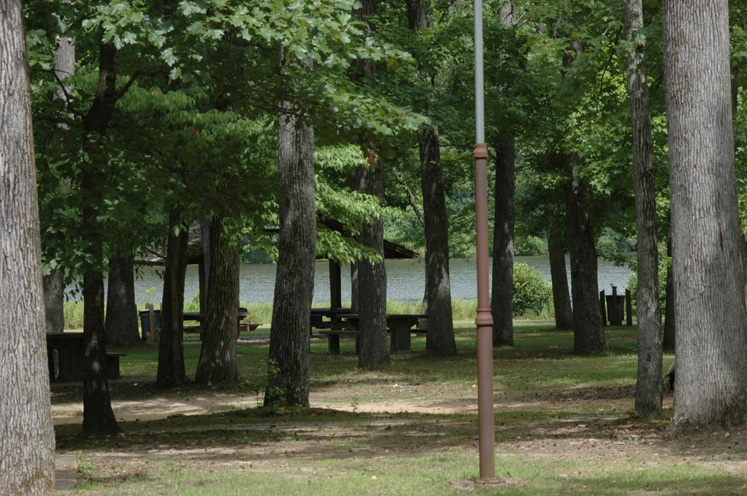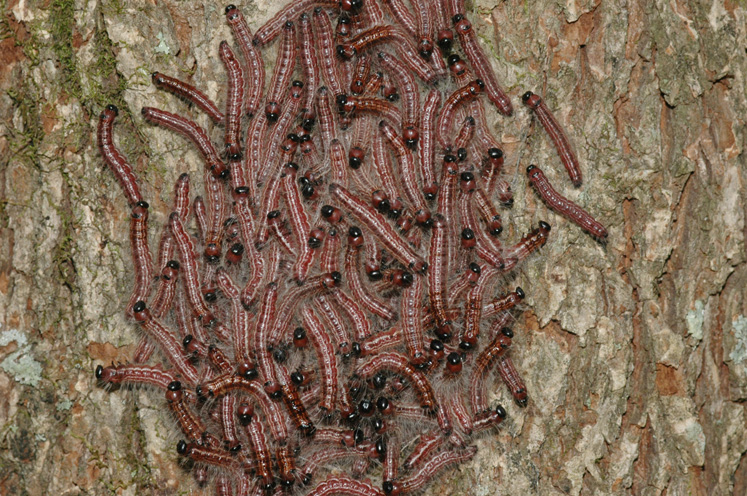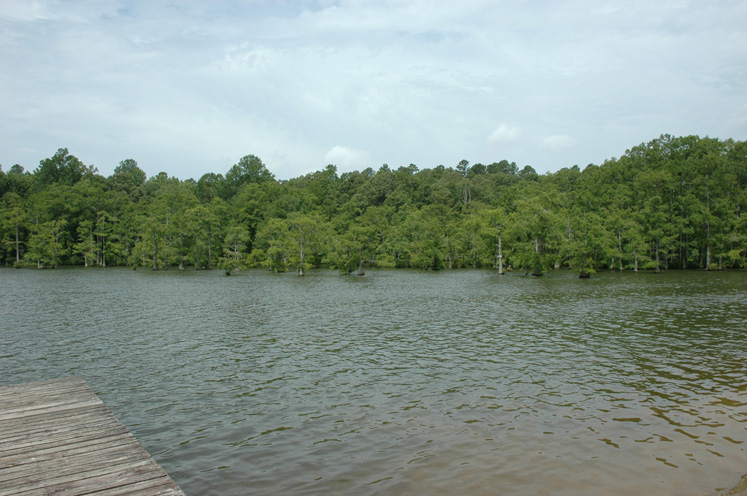Ants in Wall Doxey State Park, Marshall County, Mississippi [MS State Park Ants]
Joe A. MacGown, JoVonn G. Hill, and Rebekah J. Jones
Uploaded June 2005; updated July 2006
Wall Doxey State Park is located on highway 7 about seven miles south of Holly Springs in Marshall County, Mississippi. This large 850 acre wooded park is centered around a 60 acre spring fed lake. The park has many of the typical attractions including cabins, camping sites, nature trails, etc. A very nice nature trail, which passes through various forest types and elevations, winds its way around the lake.

The spring fed lake at Wall Doxey State Park.
Our first journey to Wall Doxey State Park occurred on 23 June 2005. This particular trip was in conjunction with collections at some other localities in the area and consequently we didn't get to spend a lot of time here. However, our time was well spent and we collected several very interesting ants and 33 species altogether.
After making a quick circuit of the park, we decided to begin collecting along a somewhat sandy nature trail that started near the boat launch area. A latitude/longitude reading was taken of 34°39'54"N 89°27'58"W at the beginning of the trail, but obviously this is not meant to be all inclusive as we wandered down the trail considerably past that point. This part of the lake had lots of cypress trees and the trail itself was bordered by many large loblolly pines, oaks, tulip magnolias, and other hardwood trees. The beginning of the trail was in an open area with scattered magnolias (southern magnolia), tulip trees, and other trees. This part of the trail was littered with many colonies of Lasius americanus Emery and Pheidole bicarinata Mayr. Many individuals of the black carpenter ant, Camponotus pennsylvanicus (DeGeer), and the slightly smaller reddish colored Formica pallidefulva Latreille were seen running around on the ground. As we walked along the trail, we put some peanut butter on some of the larger trees, which resulted in the collection of several species that we also collected otherwise including Prenolepis imparis (Say), Solenopsis sp. cf. molesta (Say), and Crematogaster ashmeadi Mayr. The minute, golden colored Solenopsis species, also called thief ants, were very common in the area and were also seen nesting in pine bark and in soil and leaf litter.
While we were crawling around on the trail on the lookout for ants and any other cool insects, a mother and her young daughters ambled by and were interested in what we were doing. It turned out that the mother was a former entomologist herself and the fact that we were getting hot and grungy while searching for insects made perfect sense to her. We talked about what we were doing for a while, and then got back to work.
Three species of Aphaenogaster were collected including Aphaenogaster carolinensis (Wheeler), A. fulva Roger, and A. lamellidens Mayr. For the most part these are wood colonizing ants, especially being found in rotting wood, except for A. carolinensis, which is often found nesting in the soil. Several other common forest inhabiting ants were collected nesting in leaf litter including Paratrechina faisonensis (Forel), Camponotus chromaiodes Bolton, C. pennsylvanicus, and Pheidole dentigula Smith. Another common Pheidole species, P. dentata Mayr, was found in rotting wood. While in this area, several bags of soil and leaf litter was collected and taken back to the lab for Berlese funnel extraction.
After collecting at the trail area for a couple of hours or so, we went over to the other side of the park and collected near a pavilion (called picnic hill) at 34°39'37"N 89°27'54"W that was near the picnic area and just before the entrance to the camp sites. This site proved to be very interesting as we found some army ants crawling on the ground under some oaks and pines near a wooded slope. This particular species, Neivamyrmex carolinensis (Emery), represented the only recent collection of this species in Mississippi. We have often wondered if the paucity of this species had something to do with the increased presence of the imported red and black fire ants during the last 50 years. We did find fire ants here at Wall Doxey, although only in small numbers and in small colonies rather than the more typically large mounds. The species in this area was either the black one, Solenopsis richteri Forel, or the hybrid between the red and black species, Solenopsis invicta X richteri. It is practically impossible to separate the hybrid from the black imported fire ant using morphological characters and further mention of this species in this log will refer to it as either the imported fire ant or Solenopsis invicta X richteri? We collected two species of Paratrechina in this general area: P. arenivaga (Wheeler) and P. vividula (Nylander). Both of these species are typically found in relatively open areas with P. vividula generally being more common, whereas the yellowish colored P. arenivaga is usually restricted to sandy habitats. Colonies of the fungus growing ant, Trachymyrmex septentrionalis (McCook), were found nesting on top of the hill near the pavilion. We also found another species that often nests in open areas, the little black ant, Monomorium minimum (Buckley).

Rebekah (a.k.a. pirate girl), looking through some soil for ants.
Another litter sample was collected from the wooded slope behind the pavilion. Quite a few species of ants were collected as a result of the different litter samples we collected at the two sites, including many of the species that we had collected otherwise, but also several other species. Other species we found in the litter included Brachymyrmex depilis Emery, Camponotus subbarbatus Emery, Hypoponera opacior (Forel), Ponera pennsylvanica Buckley, Stigmatomma pallipes (Haldeman), Discothryea testacea Roger, Proceratium crassicorne Emery, Proceratium pergandei (Emery), Strumigenys dietrichi Smith , Strumigenys ohioensis Kennedy & Schramm, Strumigenys pilinasis Forel , Strumigenys reflexa Wesson & Wesson , Strumigenys rohweri Smith , and Strumigenys rostrata Emery. Several of these species are considered to be rare or are only rarely collected in Mississippi. Some of these species, including Stigmatomma pallipes, in the subfamily Amblyoponinae, and D. testacea, P. crassicorne Emery, and S. pergandei , in the subfamily Proceratiinae, appear to be good indicators of habitat and we usually don't find them in very disturbed sites. Discothryea testacea is a minute, wasp-like species that was only reported from Mississippi recently (MacGown and Brown, 2006). Strumigenys pilinasis has been found infrequently in the state and S. ohioensis and S. reflexa were only recently discovered to occur in Mississippi (MacGown et al, 2005). Strumigenys rohweri is an extremely rare species that was originally described by Marion Smith from specimens from Marshall County. This species is only known from one other locality, also in Mississippi, in Monroe County. A few more specimens of the army ant was collected in the litter sample taken from the pavilion area. The Eastern ant cricket, Myrmecophilus pergandei Bruner, was also found in the litter samples. This myrmecophile was only recently discovered to occur in the state (MacGown and Hill, 2006) and is only known from a handful of locations in Mississippi.

The picnic area, home to many ants.
Because of some of the interesting species of ants we collected on 23 June 2005, we decided to make a return trip to Wall Doxey and see if we could add to the list of species and perhaps re-find some of the uncommon species that we had previously encountered. Unfortunately, we were not quite as optimistic as we might have been because the summer had been unseasonably dry. So, on the unlikely morning of 11 July 2006 we again headed out to collect ants at Wall Doxey. Having made an early getaway, we arrived at the park at around 9:40 A.M. We first went to the park office and talked to the manager, Lyle Richardson, about our ant collecting plans. He seemed interested in knowing if the park was home to any unusual species and we told him that we would let him know what we collected and also that we would be putting this information on our web site. As we were walking out the door of the office, we paused to observe the multitudinous butterflies and skippers, flies, wasps, and bees on the flowering lantana. As we peered farther down to the ground we spotted three species of ants: Forelius mccooki (McCook), Monomorium minimum (the little black ant), and the imported fire ant. Forelius is a very common species that we had somehow overlooked on our first visit to this park, although it was surely there then.
After looking around in front the office for just a few minutes we then drove around the park to determine where we wanted to collect. The loop through the campsite area looked interesting enough, but we decided not to collect there because we didn't want to disturb any campers and the woodland didn't appear to be significantly different from other areas in the park. We ended up starting our collections at the picnic area at 34°39'41"N 89°27'56"W, as nobody was yet there and it was a nice open wooded habitat with sandy soil. This area had many mature hardwood trees and bordered the lake. Sandy soils, like those seen here, often support high ant diversity and we noticed ant activity right away. We had barely got out of the truck when we noticed numerous ants crawling on the ground. Of course, the ever-present black carpenter ant was seen running around on the ground, on trees, and on picnic tables. A related species, Camponotus decipiens Emery, which is bicolored red and black, was collected on tree trunks. We found several nests of Formica pallidefulva in the immediate area, which we dug through in search of either slave making Polyergus ants, or for the sundry myrmecophiles that are known or unknown to occur with this species. In one nest, some scarabaeid larvae, possibly in the genus Cremastocheilus, were found and taken back to the lab to see if they could be reared to adults to determine the species. One of the Formica colonies that we found appeared to have been dug into by some other creature than a myrmecologist and the entrance to the colony was therefore in a depression. At the entrance to this particular nest we found many dead millipedes scattered about. Although the millipedes were not definitively identified, they appeared to be an exotic species, Oxidus gracilis, which we often find in great numbers in Mississippi. Also in the area, several Formica workers were observed trying to carry a live scarab beetle, Euphoria sepulcralis. The beetle was on its back as the ants attempted to drag it by its appendages, presumably to their colony. Another ant, Lasius alienus, in the same subfamily (Formicinae) as the aforementioned species, was found nesting in many small colonies in the soil. A related species, L. neoniger Emery, was also collected in this area. While searching the area, we found one more related species, Paratrechina vividula, a common roadside species.

Scattered millipede bodies at Formica pallidefulva nest entrance.
Nesting side by side with the Lasius and in great numbers, were two species of myrmicine ants, Pheidole bicarinata and Pheidole n. sp. Although these two species are related and both have major and minor workers, they are quite different in appearance as P. bicarinata is much smaller and lighter colored, whereas P. n. sp. is larger and darker colored. Pheidole n. sp. is a relatively rare undescribed species in the Pheidole crassicornis group that appears to have a southeastern distribution. A large colony with brood of another related species, P. dentata Mayr, was collected nesting in the soil in this area. This spot was apparently suitable for Pheidole species as we found workers of yet another species, Pheidole tysoni Forel. This species differs from the other Pheidole species we collected in that it is has a shiny yellow appearance. Another species, Aphaenogaster treatae Forel, in the same tribe as Pheidole, was found at this locality. This is a large reddish colored species that can be identified by its distinctive lobes that are found on the basal portion of the antennal scapes. Several colonies of Monomorium minimum and the fungus growing Trachymyrmex were found nesting in the area. A couple of other common species, Crematogaster lineolata (Say) and Temnothorax pergandei Emery, in the Myrmicinae subfamily were found crawling on the ground in the area. Temnothorax pergandei is a variably colored species, but typically those seen in open areas such as this are dark, almost black colored, and superficially resemble fire ants or dark colored Pheidole species.
This open habitat proved to be ideal for two species of dolichoderine ants, Dorymyrmex bureni (Trager) and Forelius mccooki, both of which species we found several colonies of. Ants in the genus Dorymyrmex are often called pyramid ants because of the dome shaped mounds they build that surround their nest entrances. They are dominant species that appear to be able to hold their own against the imported fire ants and indeed, we saw no fire ants in this area, although that may have had nothing to do with it. Lots of various species of female mutillid wasps, which are very similar in appearance to ants, were seen crawling around this area as well.
We had put some peanut butter bait out on some of the larger trees in the area and collected several species at the bait including Camponotus decipiens, C. pennsylvanicus, Formica pallidefulva, and Crematogaster ashmeadi. While looking at the trees we noticed a large mass of caterpillars near the base of a tree.

Caterpillars massed on tree base.
After a couple of hours, we left this area and went over to the trail by the boat launch area, where we had collected the previous year. Before starting our collections, we noted the presence of some large (about a foot in diameter) globular, gelatinous blobs floating around the edge of the lake. These alien looking creatures, or brain-like masses are amazingly cool and are actually colonies of millions of tiny colonial animals called bryozoans. They are supposed to be good indicators of untainted water, so apparently this spring fed lake was relatively unpolluted.

Rebekah holding a bryozoan colony
As we walked in to the trail, we again noted the presence and abundance of Lasius alienus and Pheidole bicarinata nesting in the soil. Continuing on down the trail we collected many of the same species that we had found the year before including the same three Aphaenogaster species, A. carolinensis, A. fulva, and A. lamellidens, as well as one additional species, A. treatae. The first three of these species were very common here, whereas we only found one individual worker of A. treatae crawling on the ground. We found several colonies of Camponotus pennsylvanicus nesting in the leaf litter and soil, which was a little unusual as this species more typically nests in rotting wood. As we walked along the trail, individuals of Formica pallidefulva were seen randomly scurrying about. An individual of Strumigenys rostrata was collected in leaf litter that was accumulated in a depression found on a slope in a part of the forest that was mostly deciduous in composition. Although Strumigenys species are minute and very cryptic, usually moving only very slowly, this particular species is somewhat larger than many others and has a tendency to move faster. This difference makes it ever so slightly easier to pick them out in a batch of litter.
While searching in a rotting log, Lasius aphidicola (Walsh), a new species for the park, was found nesting. Ripping away more of the log revealed that the colony was extensive and it also extended into the soil below. This yellow colored species of Lasius has only been collected sporadically in the state and was a nice catch. This species shared space in the log with a large colony of Aphaenogaster species. Lasius alienus, a darker species that we had already collected elsewhere in the park, including at the beginning of the trail, was found to be abundant in the soil in the woods on either side of the trail. Some of these areas were somewhat low and wet, and this is typical habitat for this species. Paratrechina faisonensis (Forel), a relative of Lasius, was also very common in the litter in the woods and was seen in great numbers. This is a small dark brown woodland species that we have found to be common throughout the state in rich woods. In the higher areas of the trail, we saw numerous nests of Trachymyrmex septentrionalis, although we had to search hard to find an active colony. The only colony we found with workers present was located next to a wooden step on the trail and in this case many workers were observed around the colony entrance. Digging into the colony revealed a fungus garden of an almost spherical shape with a diameter of approximately 6 cm. While digging into that colony, a colony of A. carolinensis was found abutting the fungus ant nest. As far as the other fungus ant colonies were concerned, we assumed that because they were mostly more exposed that perhaps the workers were deeper in the soil and therefore the colonies appeared to be inactive when we dug into them.
Surprisingly, we saw no imported fire ants along the trail, which is enough to make anyone happy. We did find many representatives of the related, but much smaller thief ant throughout the woods. While sifting litter, we noticed an obvious lack of ponerine ant activity, which was somewhat unusual considering their typical abundance in forests. Maybe the drier than normal soil conditions caused them to go deeper into the soil.
Several of the larger trees along the trail were baited with peanut butter, which attracted Aphaenogaster lamellidens and Temnothorax schaumii Roger.

A view of the lake near the boat launch area.
While wandering around this area, we collected 15 gallon sized bags of litter and soil to take back for Berlese extraction. The samples were taken from a variety of places such as at the bases of loblolly pine (Pinus taeda), oaks (Quercus spp.), cypress (Taxodium distichum), and other trees, from underneath rotting logs, and from depressions found on forested slopes. The litter sample taken from the depression found on the slope had several common species in it such as Paratrechina faisonensis, Ponera pennsylvanica, Solenopsis sp. cf. molesta, Aphaenogaster carolinensis, Pheidole dentigula, and Myrmecina americana and several very interesting species as well including Proceratium silaceum Roger, Stigmatomma pallipes, Strumigenys pergandei Emery, S. rostrata , S. talpa Weber , and Temnothorax tuscaloosae (Wilson). A litter sample taken from the base of a loblolly had P. faisonensis, H. opacior, S. rostrata , A. fulva, and Myrmecina americana Emery in it. The sample of cypress litter had several species in it including L. alienus, P. faisonensis, Ponera pennsylvanica, S. rostrata , M. minimum, Solenopsis sp. cf. molesta, Crematogaster vermiculata Emery, T. curvispinosus, and M. americana. Cremagaster vermiculata, a new state record for Mississippi, has also been collected in other localities within the state and will be included in a future manuscript documenting ants of Mississippi that is being prepared by the MEM. Another interesting find in the cypress litter was the presence of four individuals of the Eastern ant cricket, Myrmecophilus pergandei. We had collected this unique myrmecophile at the park the year before and were excited to find it once again. Additional species collected in other litter samples taken from the woods in this area included Camponotus chromaiodes, Strumigenys ornata , S. pulchella Emery, S. reflexa , S. louisianae, Stenamma impar Forel (a dealate queen), Aphaenogaster fulva, A. lamellidens, Pheidole dentigula, and Crematogaster lineolata.
After spending almost 3 hours searching for ants and collecting litter in the woods near the nature trail, we decided to go back to the pavilion area where we had found the army ants the year before to see we could find some more. As we headed back to the truck, we heard pleas of help from a local fisherman, who had been fishing for bream. He was holding a duck in his hands, which had somehow managed to get the man's hook into the base of its wing. We went over to see if we could be of assistance, and with JoVonn's aid, the duck came out of the incident without serious injury or psychological damage.
We went over to the pavilion area, arriving at approximately 3:00 P.M. and checked it out for ants. We noticed some small scattered colonies of the imported fire ant here. Most of the colonies were next to curbs or other raised areas. We also found a few minor workers of Pheidole bicarinata and P. tysoni crawling on the ground. We looked for the presence of the army ants we had hoped for in the same general area as the year before, but had no luck finding them. However, in some wood chips that were underneath an oak tree, we found hordes of Hypoponera opacior. Since there was so much ant activity, we grabbed up some of this wood chip material to take back for Berlese funnel extraction. Unfortunately, the wood chip sample only had fire ants, Hypoponera opacior, and Temnothorax curvispinosus in it. We left the park soon thereafter, and headed back to MSU.
Between the two trips to the state park a the total 56 species of ants were collected. Several of the ants collected at the park on the two occasions are considered to be rarely collected species including Lasius umbratus, Neivamyrmex carolinensis, Stigmatomma pallipes, Discothryea testacea, Proceratium crassicorne, Pr. pergandei, Pr. silaceum, Strumigenys pilinasis , S. rohweri, S. talpa , Pheidole n. sp., Crematogaster vermiculata, Temnothorax schaumii, and T. tuscaloosae, or species only recently discovered to occur in Mississippi (some of which are also considered rare) such as Camponotus subbarbatus, Strumigenys ohioensis, S. reflexa , S. talpa , and T. tuscaloosae (MacGown et al, 2005; MacGown and Brown, 2006). Strumigenys pergandei is a new state record for Mississippi, and this locality represents the only collection of this species in the state. Crematogaster vermiculata and Stenamma impar are also new state records, but have been collected in several other counties in Mississippi. One of the Pheidole species collected is an undescribed species that is also somewhat uncommonly collected in Mississippi, but appeared to be very common at the picnic area.
Overall, for the few total hours on only two occasions collections were made, the park proved to have a high diversity of ants with a healthy mix of common and rare species. Only one exotic species, the imported fire ant, was seen, and only in low numbers (as compared to many places in Mississippi). Many factors contribute to an area providing suitable habitat for such an array of species. Fortunately, this state park, as well as many others, provides an area with a fairly large tract of relatively undisturbed forest with the presence of many large trees. The park offers elevational changes and several distinct habitat types. Additionally, this park is situated far from the coast line and therefore does not suffer from the onslaught of exotic ants that are entering the state via coastal ports. Exotic species appear to have negative effects on native species. We have seen this phenomenon first-hand at several localities (including state parks) in the southern portion of the state that had large concentrations of exotic ants and apparent reduced numbers of native ant populations.
List of ant species collected at Wall Doxey State Park (arranged alphabetically by genus)
Aphaenogaster carolinensis (Wheeler)
Aphaenogaster fulva Roger
Aphaenogaster lamellidens Mayr
Aphaenogaster treatae Forel
Brachymyrmex depilis Emery
Camponotus chromaiodes Bolton
Camponotus decipiens Emery
Camponotus pennsylvanicus (DeGeer)
Camponotus subbarbatus Emery
Crematogaster ashmeadi Mayr
Crematogaster lineolata (Say)
Crematogaster vermiculata Emery
Discothryea testacea Roger
Dorymyrmex bureni (Trager)
Forelius mccooki (McCook)
Formica pallidefulva Latreille
Hypoponera opacior (Forel)
Lasius americanus Emery
Lasius neoniger Emery
Lasius aphidicola (Walsh)
Monomorium minimum (Buckley)
Myrmecina americana Emery
Neivamyrmex carolinensis (Emery)
Nylanderia arenivaga
(Wheeler)
Nylanderia faisonensis (Forel)
Nylanderia vividula (Nylander)
Pheidole bicarinata Mayr
Pheidole dentata Mayr
Pheidole dentigula Smith
Pheidole tysoni Forel
Pheidole n. sp.
Ponera pennsylvanica Buckley
Prenolepis imparis (Say)
Proceratium crassicorne Emery
Proceratium pergandei (Emery)
Proceratium silaceum Roger
Solenopsis invicta X richteri ?
Solenopsis sp. cf. molesta (Say)
Stenamma impar Forel
Stigmatomma pallipes (Haldeman)
Strumigenys dietrichi Smith
Strumigenys louisianae Roger
Strumigenys ohioensis Kennedy & Schramm
Strumigenys ornata Mayr
Strumigenys pergandei Emery
Strumigenys pilinasis Forel
Strumigenys pulchella Emery
Strumigenys reflexa Wesson & Wesson
Strumigenys rohweri Smith
Strumigenys rostrata Emery
Strumigenys talpa Weber
Trachymyrmex septentrionalis (McCook)
Temnothorax curvispinosus Mayr
Temnothorax pergandei Emery
Temnothorax schaumii Roger
Temnothorax tuscaloosae (Wilson)
MacGown, J. A., R. L. Brown, and J. G. Hill. 2005. An annotated list of the Pyramica (Hymenoptera: Formicidae: Dacetini) of Mississippi. Journal of the Kansas Entomological Society 78: 285–289. [pdf]
MacGown, J. A. and R. L. Brown. 2006. Survey of Ants (Hymenoptera: Formicidae) of the Tombigbee National Forest in Mississippi. Kansas Entomological Society 79: 325-340. [pdf]
MacGown, J. A. and J. G. Hill. 2006. The Eastern ant cricket, Myrmecophilus pergandei Bruner (Orthoptera: Myrmecophilidae), reported from Mississippi, U.S.A. Journal of the Mississippi Academy of Sciences 51: 180-182. [pdf]


